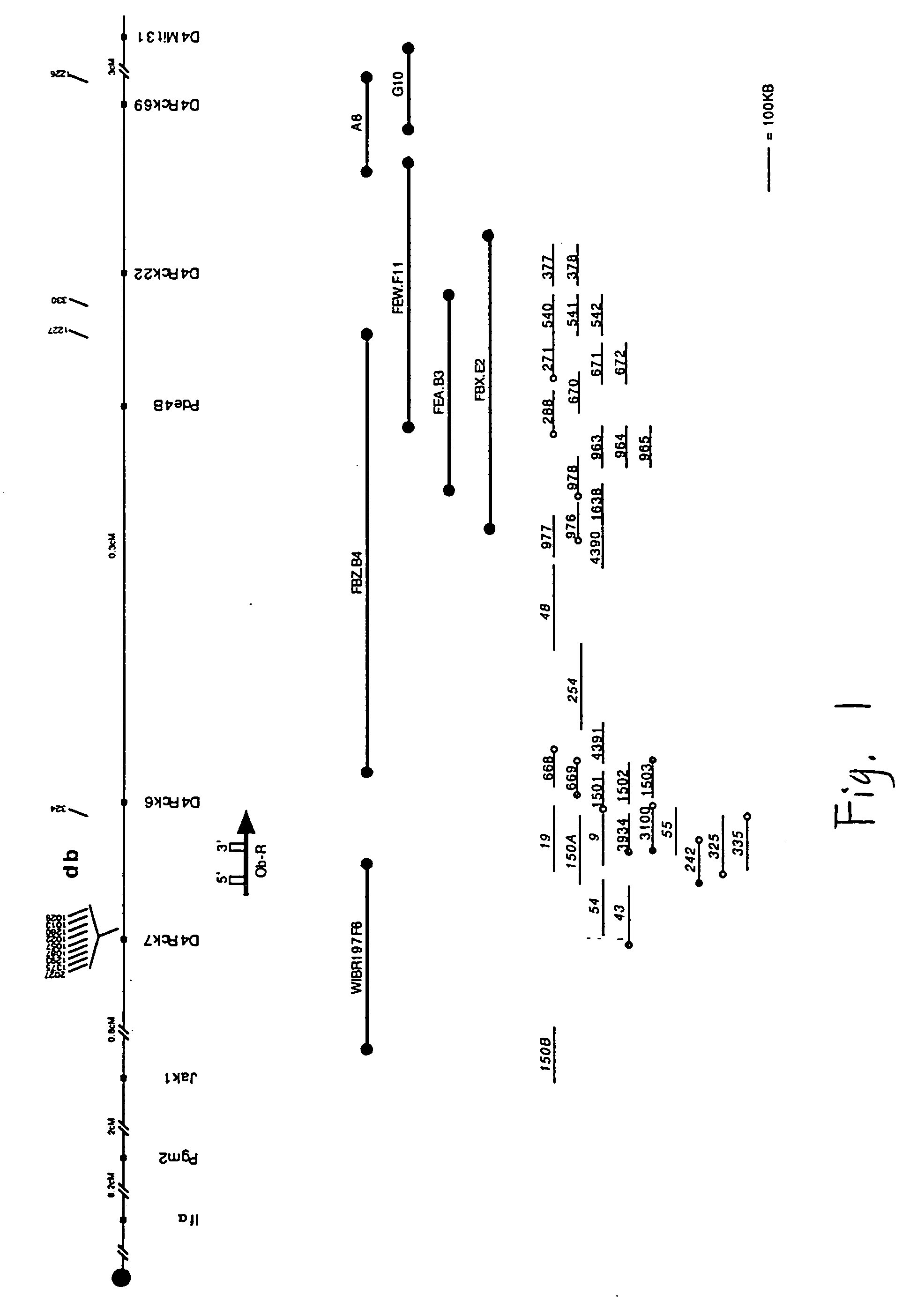DB, the receptor for leptin, nucleic acids encoding the receptor, and uses thereof
a technology of leptin and receptor, applied in the field of identification of a receptor for a satiety factor, can solve problems such as interfering with the ability to properly integrate or respond to nutritional information within the central nervous system, and achieve the effect of improving the body appearance of an individual and reducing the body weight of an individual
- Summary
- Abstract
- Description
- Claims
- Application Information
AI Technical Summary
Benefits of technology
Problems solved by technology
Method used
Image
Examples
example 1
Isolation of DB cDNA Clones
[0297] Mutations in the mouse db gene result in severe obesity and diabetes in a syndrome that resembles morbid human obesity [Hummel et al., Science, 153:1127 (1966)]. Previous data suggested that the db gene encoded the receptor for the gene product of the ob locus, known as leptin [Coleman, Diabetologia, 14:141 (1978); Zhang et al., Nature, 372:425 (1994)]. Recently, a report that the leptin receptor was cloned from choroid plexus appeared; this clone was shown to map to the same region of chromosome 4 as db [Tartaglia et al., Cell, 83:1263 (1995)]. This receptor is a member of the family of receptors that associate with the JAK tyrosine kinases. However, mutations in this receptor were not identified in C57BL / 6J db / db mice, suggesting that the mutation in these animals might be in a splice variant of this gene [Tartaglia et al., supra].
[0298] The present Example shows that the leptin receptor maps to the same 300 kB interval on mouse chromosome 4 as ...
example 2
Preparation of Antibodies to the OB Polypeptide
[0315] In addition to use of the recombinant protein to generate polyclonal antibodies, a set of three peptide sequences from the deduced full length murine OB-R sequence (i.e., SEQ ID NOS:6-10) were identified. The four internal peptide fragments are:
Peptide A (amino acid numbers 145-158) (SEQ ID NO:32):Glu-Pro-Leu-Pro-Lys-Asn-Pro-Phe-Lys-Asn-Tyr-Asp-Ser-LysPeptide B (amino acid numbers 465-484) (SEQ ID NO:33):His-Arg-Arg-Ser-Leu-Tyr-Cys-Pro-Asp-Ser-Pro-Ser-IIe-His-Pro-Thr-Ser-Glu-Pro-LysPeptide C (amino acid numbers 863-881) (SEQ ID NO:34):Gln-Arg-Met-Lys-Lys-Leu-Phe-Trp-Asp-Asp-Val-Pro-Asn-Pro-Lys-Asn-Cys-Ser-Trp
[0316] These peptides are prepared using standard solid phase peptide synthesis. The purified synthetic peptides are conjugated to KLH, and the peptide-KLH conjugates are used to immunize rabbits using standard techniques. Polyclonal antisera specific for each peptide is recovered from the rabbits.
example 3
Preparation of PCR Probes from cDNA Selection and Exon Trapping Clones
[0317] This Example describes the cDNA selection clones that were identified to correspond to OB-R. PCR primers from these clones were used as probes for OB-R cDNA and genomic clones, and are useful for identifying OB-R DNA, as well as characterizing different OB-R splice variants.
[0318] Five cDNA selection clones were found to be useful as probes: clones 7 (SEQ ID NO:35), 11 (SEQ ID NO:36), 42 (SEQ ID NO:37), 46 (SEQ ID NO:38), and 58 (SEQ ID NO:39). Two cDNA selection clones identified by hybridization with exon trapping clones were also found to be useful probes: clones S3 (SEQ ID NO:40) and S14 (SEQ ID NO:41).
[0319] PCR primers were prepared from each of the above-noted clones for use as probes in identifying OB-R DNA. Table 1 reports the forward and reverse primers for each of the clones, and notes which splice variants of OB-R, as well as the predicted coding region, each probe labels.
TABLE 1PCR Primer ...
PUM
| Property | Measurement | Unit |
|---|---|---|
| weight | aaaaa | aaaaa |
| weight | aaaaa | aaaaa |
| molecular weight | aaaaa | aaaaa |
Abstract
Description
Claims
Application Information
 Login to View More
Login to View More - R&D
- Intellectual Property
- Life Sciences
- Materials
- Tech Scout
- Unparalleled Data Quality
- Higher Quality Content
- 60% Fewer Hallucinations
Browse by: Latest US Patents, China's latest patents, Technical Efficacy Thesaurus, Application Domain, Technology Topic, Popular Technical Reports.
© 2025 PatSnap. All rights reserved.Legal|Privacy policy|Modern Slavery Act Transparency Statement|Sitemap|About US| Contact US: help@patsnap.com



